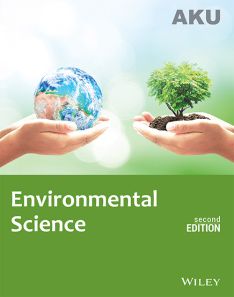Environmental Science, 2ed
ISBN: 9788126566037
292 pages
For more information write to us at: acadmktg@wiley.com

Description
This book is designed to meet the requirements of students who are inquisitive to learn about the key issues related to the environment. It provides an up-to-date introduction to study of environment and aims to familiarize the students with operational definitions and realistic classifications in the study of environment. It highlights the interdisciplinary perspective of the subject and integrates the natural sciences with environmental laws, impact, planning and management. It aims to create sensitivity in students towards environmental issues and motivates them to think through environmental problems.
Preface
Syllabus Map
1 Introduction to Environmental Science
Learning Objectives
1.1 Nature of Environment
1.2 Air Pollution
1.3 Water Pollution
1.4 Soil Pollution
1.5 Noise Pollution
1.6 Solid Waste and its Management
1.7 Sustainable Development
1.8 Renewable and Non-renewable Energy Sources
Summary
Key Terms
Objective-Type Questions
Review Questions
Answers
2 Toxicological Chemistry
Learning Objectives
2.1 Chemical Nature of Toxicants
2.2 Toxic Chemicals in the Environment
2.3 How Toxins Affect Human Beings
2.4 Chemical Toxins as Endocrine Hormone Disruptors
2.5 Impact of Toxic Chemicals on Enzymes
2.6 Biochemical Effects of Some Important Toxins
2.7 Important Factors in Environmental Toxicity
2.8 Dose-Response Relationship
2.9 Establishing Public Policy
Summary
Key Terms
Objective-Type Questions
Review Questions
Answers
3 Environmental Chemical Analysis
Learning Objectives
3.1 Introduction
3.2 Sample Collection
3.3 Neutron Activation Analysis
3.4 Atomic Absorption Spectrophotometry (AAS)
3.5 Inductively-Coupled Plasma Emission Spectroscopy (ICPES)
3.6 Anodic Stripping Voltametry (ASV)
3.7 X-Ray Fluorescence
3.8 Chemiluminescence
3.9 Infrared Spectroscopy
3.10 Chromatography
Summary
Key Terms
Objective-Type Questions
Review Questions
Answers
4 Humans and Sustainability: Ecology and Biodiversity
Learning Objectives
4.1 Biological Hierarchy
4.2 Structure and Functions of an Ecosystem
4.3 Producers, Consumers and Decomposers
4.4 Food Chains
4.5 Food Web
4.6 Ecological Pyramids and their Interrelationship
4.7 Energy Flow in the Ecosystem
4.8 Classification of an Ecosystem
4.9 Characteristic Features of Various Ecosystems
4.10 Ecological Succession
4.11 Ecology
4.12 Population
4.13 Biodiversity and its Types
4.14 Value or Importance of Biodiversity
4.15 Biodiversity at Global and National Levels
4.16 Loss of Biodiversity
4.17 Conservation of Biodiversity
Summary
Key Terms
Objective-Type Questions
Review Questions
Answers
5 Policy and Legislation
Learning Objectives
5.1 Environmental Conservation
5.2 Indicators of Environmental Degradation
5.3 Environmental Impact Assessment
5.4 Policies and Legislation at the International Level
5.5 Policies and Legislation at the National Level
5.6 Environmental Management
Summary
Key Terms
Objective-Type Questions
Review Questions
Answers
Appendices

